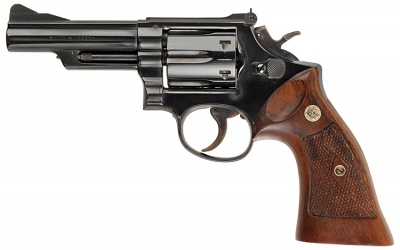
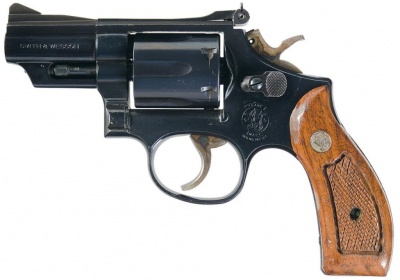
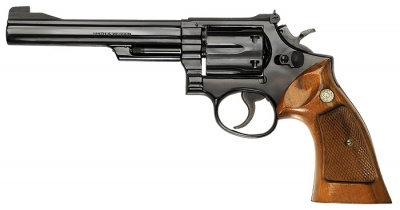
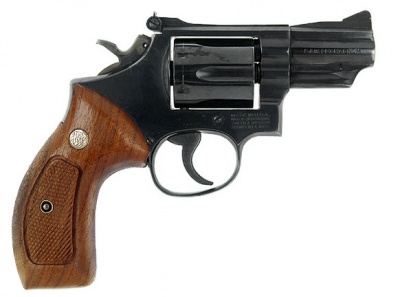
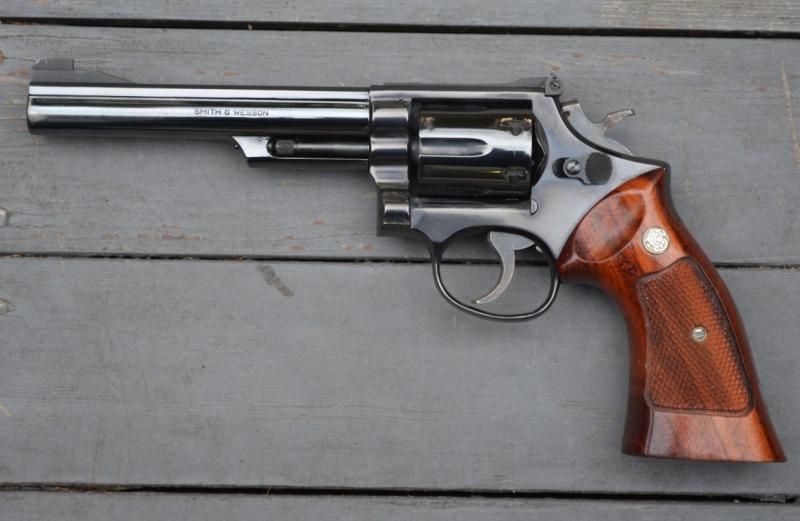
Smith & Wesson Model 19
| Smith & Wesson Model 19 | |
|---|---|

S&W Model 19-5; polished nickel, 4″ barrel
|
|
| Type | Revolver |
| Place of origin | United States |
| Production history | |
| Designer | Smith & Wesson |
| Manufacturer | Smith & Wesson |
| Produced | 1957–1999, 2014— |
| Variants | Model 66 (stainless steel) |
| Specifications | |
| Cartridge | .357 Magnum |
| Action | Double action |
| Feed system | 6-round cylinder |
| Sights | Adjustable |
The S&W Model 19 is a revolver produced by Smith & Wesson on its K-frame. The model 19 is chambered for .357 Magnum. The K-frame is somewhat smaller and lighter than the original N-frame .357, usually known as the S&W Model 27.
History
The .357 Magnum is the oldest “magnum” handgun cartridge. Smith & Wesson played a major part in the development and success of the cartridge and revolver that went with it.
Firearms writer and experimenter Philip Sharpe is credited for its development during the 1930s when police agencies were asking for a more powerful round. S&W’s Dan Wesson agreed to produce a new revolver that would handle “high-intensity” .38 Special loads, but only if Winchester would develop a new cartridge.
Elmer Keith, a well known author and wildcatter at the time, was experimenting with hand loading .38 Special ammunition beyond their original specifications, taking advantage of the newer and better designed firearm frames and metallurgy, and also played a major role in the development of the .357 Magnum.
Winchester introduced the .357 Magnum, which was dimensionally identical to the .38 Special except for a .125 inch longer case, and the first revolvers (referred to as “.357 Magnum Models”) were completed by S&W on April 8, 1935.[1]
Retired Assistant Chief Patrol Inspector of the U.S. Border Patrol, famous gunfighter, and noted firearms and shooting skills writer Bill Jordan consulted with Smith & Wesson on the design and characteristics of the Model 19. Jordan’s idea for a “peace officer’s dream”[2] sidearm was a heavy-barreled four-inch K-Frame .357 Magnum with a shrouded barrel like the big N-frame .357 and adjustable sights.
After a year of experimentation with improved-strength steels and special heat-treating processes, the result was the .357 Combat Magnum (later designated Model 19), with the first serial-number gun (K260,000) presented to Jordan on November 15, 1955.[1][3]
The .357 Magnum, four-inch barreled model was standard issue to uniformed officers of the former U.S. Immigration and Naturalization Service as well as Patrol Agents of the U.S. Border Patrol until both agencies adopted .40 caliber semi-automatic pistols.
The .357 Magnum, 2.5” barreled model was standard issue to Special Agents of the former U.S. Immigration and Naturalization Service as well as Patrol Agents of the U.S. Border Patrol working plain clothes assignments until both agencies adopted .40 caliber semi-automatic pistols.
Styles
The Model 19 was produced in blued carbon steel or nickel-plated steel with wood or rubber combat grips, an adjustable rear sight, full-target or semi-target hammer, serrated wide target trigger or combat-type trigger, and was available in 2.5″ (3″: Model 66—rare), 4″, or 6-inch barrel lengths.
The weights are 30.5 ounces, 36 ounces, and 39 ounces, respectively. The 2.5- and 3-inch barrel versions had round butts, while the others had square butts.[1]
The Model 19 was produced from 1957 (first model number stampings) to November 1999. The Model 66 was produced from 1970 until 2005.
The Model 66 differed by its use of stainless steel and its smooth target-type trigger. The Model 19 and the Model 66 had the same trigger options.[1]
Engineering changes were designated with a “dash-” number after the model number. The engineering changes are as follows:[1]
Model 19
- 19 (1957): Stamping of model number.
- 19-1 (1959): Change extractor rod, right to left-hand thread.
- 19-2 (1961): Cylinder stop changed, deleted triggerguard screw.
- (1963): Introduce 6″ barrel.
- (1963): 50 manufactured with 2.5″ barrel, serial range K544672–K544721.
- (1966): Introduce 2.5″ barrel as standard.
- 19-3 (1967): Relocation of rear sight leaf screw.
- (1968): Delete diamond-insert grip.
- 19-4 (1977): Change gas ring from yoke to cylinder. (Not really an “improvement”. It did make it slightly easier to clean if there was heavy leading, but basically was a cost-cutting measure.)
- 19-5 (1982): Eliminate cylinder counterbore and pinned barrel; small change in cylinder length to 1.62″.
- 19-6 (1988): New yoke retention system; radius stud package; floating hand; hammer nose bushing.
- (1992): Blue finish only is catalogued.
- 19-7 (1994): Change to Uncle Mike’s Combat synthetic grips; drill and tap frame; change extractor; change rear sight leaf.
- (1995–96): Delete square butt features.
- (1996): Discontinue 6″ barrel production; begin shipments in blue foam-filled plastic cases.
- (1997): Change to MIM thumbpiece; ship with Master trigger locks; change to MIM trigger.
- 19-8 (1998): Change in frame design: cylinder stop stud eliminated; eliminate serrated tangs; change to MIM hammer with floating firing pin; change internal lockwork, September 1998.
- (1999): Discontinue 2 1/2″ barrel.
Model 66
- 66 (1971): Stamping of each model.
- 66-1 (1977): Changed the gas ring from the yoke to the cylinder.
- 66-2 (1982): Eliminated pinned and recessed, slightly lengthened cylinder.
- 66-3 (1986): New yoke retention system/radius stud package/hammer nose bushing/floating hand.
- 66-4 (1994): Change rear sight leaf, drill and tap frame, introduce Uncle Mike’s grips, change extractor.
- 66-5 (1998): Change in frame design: eliminate cylinder stop stud/eliminate serrated tangs/change to MIM hammer with floating firing pin/change internal lockwork.
- 66-6 (2002): Introduced internal lock.
- 66-7 (?): Two piece barrel and internal lock,
- (2005): Discontinued.
- 66-8 (2014): Reintroduced with 4.25″ barrel in 2014 and later with a 2.75″ barrel in 2017.
Users
- Texas Alcoholic Beverage Commission
- U.S. Border Patrol
- U.S. Air Force
- Immigration and Naturalization Service (former United States agency, now part of several agencies in the U.S. Department of Homeland Security)
- South Australian Police
- Rhode Island State Police
- Bundesnachrichtendienst
- GSG 9
- Diplomatic Security Service
- Special Security Team
- Norwegian Police Service
- North Carolina Highway Patrol
- Naval Criminal Investigative Service
- United States Secret Service
- F.B.I.
- Seal Team Six
- Tarrant County Sheriff’s Office
- Frank Reynolds
- Daisuke Jigen
References
- ^ Jump up to:a b c d e Supica, Jim; Nahas, Richard (3 January 2007). Standard Catalog of Smith & Wesson. Iola, Wisconsin: F+W Media, Inc. pp. 136, 186–188. ISBN 0-89689-293-X.
- Jump up^ Taffin, John (2006). “The combat magnum: good gun gone”. Guns Magazine. Retrieved 2009-08-02.
- Jump up^ Sweeney, Patrick (2004). The Gun Digest Book of Smith & Wesson. Iola, Wisconsin: Gun Digest Books. pp. 40–41. ISBN 0-87349-792-9.
